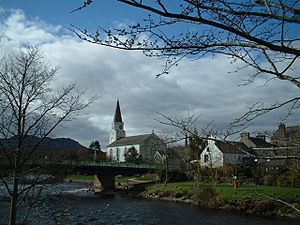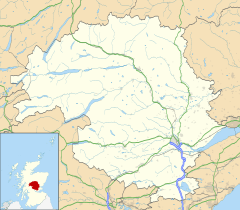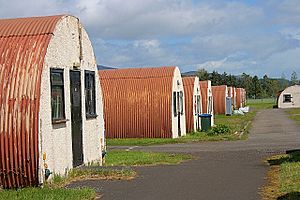Comrie, Perth and Kinross facts for kids
Quick facts for kids Comrie
|
|
|---|---|
 Comrie |
|
| Population | 1,900 (2020) |
| OS grid reference | NN773219 |
| Council area | |
| Lieutenancy area | |
| Country | Scotland |
| Sovereign state | United Kingdom |
| Post town | Crieff |
| Postcode district | PH6 |
| Dialling code | 01764 |
| Police | Tayside |
| Fire | Tayside |
| Ambulance | Scottish |
| EU Parliament | Scotland |
| UK Parliament |
|
| Scottish Parliament |
|
| Website | /www.comrie.org.uk |
Comrie (/ˈkʌmri/) is a village in the southern Scottish Highlands of Scotland. It is found in the Perth and Kinross area, about 7 km (4.3 mi) west of Crieff.
Comrie is a special village located in a national scenic area along the River Earn. It sits right on the Highland Boundary Fault, which is why it experiences more small earthquakes than any other place in Britain! The village is also twinned with Carleton Place, Ontario, Canada.
Contents
Where is Comrie?
Comrie is in Perthshire, a county in Scotland. The name Comrie comes from an old Gaelic word meaning "flowing together" or "the place where rivers meet." This name is perfect because three rivers join up right at the village!
The River Ruchill and the River Lednock both flow into the River Earn in Comrie. The River Earn then flows into the larger River Tay.
Because Comrie is on the Highland Boundary Fault, it often has small earth tremors. This has earned it the nickname "Shaky Toon" in the Scots language. In the 1830s, over 7,000 tremors were recorded! Today, Comrie still records more earthquakes than anywhere else in the UK. In 1840, Comrie became home to one of the world's first seismometers, a device that measures earthquakes. You can still see a working copy of it in the Earthquake House in Comrie.
Comrie is also known as the "Gateway to the Highlands." To the north, you can see the tall Ben Chonzie mountain and the Grampian Mountains. To the south, there are wide open areas and smaller mountains.
A Look Back in Time: Comrie's History
People have lived in the Comrie area for a very long time. You can find many standing stones and old remains that show us about the early people who lived here, including the Picts and Celts.
Around 79 AD, the Roman Army General Gnaeus Julius Agricola chose the edge of Comrie for a fort. This was because it was a good spot to control the southern part of the Highlands. It was one of several Roman forts built to block glens (valleys). A famous battle between the Celts and Romans, called Mons Graupius, might have happened near Comrie.
Scottish kings, like James V of Scotland, used to visit Comrie and Cultybraggan often to hunt deer.
Comrie first became important for weaving, where people made cloth at home. It was also a key stop for droving cattle. This meant that cattle were herded from the Highlands south to markets in Scotland and England. River crossings in places like Comrie were important resting spots.
Over time, Comrie grew to include smaller nearby settlements. One of these was The Ross, a small area on a river peninsula. It became easier to reach when the Ross Bridge was built in 1792. Before that, you could only get there by crossing the river. Many small communities in the surrounding glens, like Invergeldie and Dalchruin, also became part of Comrie. Sadly, many of these Gaelic-speaking communities were greatly affected by the Highland Clearances in the 18th and 19th centuries, when many people were forced to leave their homes.
In the 1800s, Comrie became a popular place for wealthy people and visitors. This led to the railway arriving in 1893, connecting Comrie to Crieff. The railway later extended further, but it closed in the 1950s and 60s as roads improved.
Because of its mountains, streams, and lochs, Comrie also became home to several hydro-electric power plants in the early 1900s.
Today, Comrie is a lovely village, especially popular with people who are retired. It also attracts visitors for adventure and wildlife tourism.
What to See and Do in Comrie
Buildings and Design
The White Church is one of Comrie's most famous buildings. It has a tall tower and spire and stands in the old churchyard in the middle of the village. This spot has been a Christian site for a very long time. The grand Comrie Parish Church was built in 1881. Comrie also has a shop designed by the famous Scottish architect Charles Rennie Mackintosh.
Many buildings in the village are very old, some dating back centuries. You can see traditional Highland cottages made of stone. In the mountains around the village, you might even find the ruins of old Highland blackhouses. Most of the main parts of the village have Victorian and Edwardian buildings, including large houses and smaller terraced homes. Newer parts of the village have more modern houses.
Awards for Beauty
Comrie has won many awards for its beauty! It won the Royal Horticultural Society "Large Village Britain in Bloom award" in 2007 and 2010. It also won "Best Village" in the Beautiful Scotland Campaign in 2009 and 2013.
Glen Lednock and the Deil's Cauldron
To the north of Comrie, on a hill called Dùn Mòr, stands a tall granite obelisk. This monument was built in 1812 to remember Henry Dundas, 1st Viscount Melville. You can reach it by following a path through Glen Lednock, a wooded valley.
In Glen Lednock, you'll find the amazing De'il's Cauldron, also known as the Falls of Lednock. The path starts in the village and goes through a forest of native trees. After crossing "The Shaky Bridge" (which isn't so shaky anymore!), you get a great view of the glen. From there, you can easily reach Dùn Mòr and the Monument, which offers fantastic views across the area.
The path then goes down into a steep, wooded gorge where the impressive De'il's Cauldron is. Here, the river has carved a tall, waterfall into the rock, with pools below that look like a boiling pot. Legend says a water-elf, Uris-chidh, lives here and tries to trick people into the dangerous waters. Further down the path, you'll find "The Wee Cauldron," a smaller, calmer waterfall. The path eventually leads back to the village.
Prisoner-of-War Camp
South of Comrie is a military camp called Cultybraggan. During World War II, it was a POW camp for Italian and German prisoners.
The camp also has a two-story nuclear bunker. This bunker was planned to be a secret government base for Scotland in case of a nuclear attack. In 2007, a local community group bought the camp and 90 acres (36 ha) of land.
In 2016, a former German prisoner from the camp, Heinrich Steinmeyer, left £384,000 to Comrie in his will. He did this to show his thanks for the kindness he received in Scotland during and after his time as a prisoner.
Other Interesting Sights
- Ben Chonzie: A mountain that overlooks the village, known for its many mountain hares.
- Cultybraggan: An old farming site and the location of the former secret nuclear bunker and a high-security POW camp.
- The Lynn: A deep freshwater pool, also known as Linn a' chullaich, popular for swimming in summer.
- The Deil's Cauldron: A deep rock waterfall with a legend of a water-elf.
- The Earthquake House: A small research station with one of the world's first seismometers, still working today.
- Tullichettle: An ancient churchyard.
- Auchingarrich: An old farming site, now a wildlife centre.
- Loch Earn: A beautiful freshwater loch surrounded by mountains.
- Ben Vorlich (Loch Earn): A nearby mountain.
- Fort Victoria: The remains of a Roman fort, possibly the furthest north the Romans reached in Scotland.
- Standing stones: Ancient stones from pre-Christian times.
- Melville Monument: A 72-foot (22 m) granite obelisk on a hill overlooking the village.
- Dundas Monument: A similar, but smaller, obelisk to the east.
- Glen Artney: A beautiful glen and old royal deer forest, mentioned in Sir Walter Scott's poem The Lady of the Lake (poem).
- Glen Lednock: A beautiful glen above the village, home to lots of wildlife like Scottish wildcats, capercaillie, and golden eagles.
- Sput Rolla: A waterfall on the River Lednock.
- Lawers House: A grand estate home.
- St Kessog's Free Church of Scotland: A large church built in 1879.
- The White Church: Built in 1805, it's a central part of the village and now a community centre.
- Brough and Macpherson shop: A building redesigned by Charles Rennie Mackintosh.
- The House of Ross: A grand estate home with a miniature railway that sometimes opens to the public.
- Aberuchill Castle: A grand castle built in 1602, now owned by a Russian industrialist.
- Dunira Castle: A grand estate west of the village.
Village Life
Comrie has many useful places, like a primary school, a post office, two hotels with restaurants, several churches, two small cafés, a restaurant, and a petrol station.
The railway that used to connect Comrie to Perth closed in 1964.
Flambeaux Parade and Hogmanay
Comrie has a very special Hogmanay (New Year's Eve) tradition. Right at midnight, a torchlight parade marches through the village. Twelve strong men carry long, thick birch poles with burning rags attached. They take these torches to the four corners of the village. The village pipe band and villagers in costumes often join the parade.
After the parade, the torches are thrown from the Dalginross Bridge into the River Earn. No one is completely sure how this tradition started. Many believe it has very old roots, perhaps from pre-Christian times. It might have been a way to clean the village of bad spirits before the new year. The birch tree is also a symbol of new beginnings.
This amazing event brings thousands of visitors to Comrie every Hogmanay. After the parade, people gather for traditional Scottish music and dancing. Many families also have parties at home and follow other Scottish New Year traditions.
Comrie Fortnight
Every year in July and August, Comrie holds a two-week festival called the Comrie Fortnight. This festival started in the late 1960s and has grown to include many activities. There are competitions, outings, dances, and a fun parade with floats. The money raised from the Comrie Fortnight helps support local groups and events in the community.
Language in Comrie
Today, the main languages spoken in Comrie are English, Gaelic, and Scots.
In the past, Comrie and the surrounding area were mostly Gaelic-speaking. In 1799, it was noted that "The common language of the people is Gaelic and all the natives understand it." However, over time, English became more common. This was partly due to the Highland Clearances, which forced many Gaelic speakers to leave their homes. Also, a law in 1872 meant that children were often not allowed to speak Gaelic in school.
Even though Gaelic speakers have faced challenges, Comrie still has a higher number of Gaelic speakers than many other parts of Scotland.
Famous People from Comrie
- Carly Booth (born 1992): A professional golfer who was born and lives in Comrie.
- Robert Burns (1759–1796): Scotland's famous national poet, who spent time at Aberuchill Castle.
- John Craig (1896–1970): A brave soldier who received the Victoria Cross award.
- Vladimir Lisin (born 1956): A wealthy Russian businessman who owns Aberuchill Castle in Comrie.
- James Drummond MacGregor (1759–1830): From Comrie, he became the first Gaelic-speaking Presbyterian minister in Nova Scotia, Canada.
- Alexander Trees, Baron Trees (born 1946): A professor and member of the House of Lords, with a title connected to a street in Comrie.
Comrie Golf Club
Comrie Golf Club was started in 1891 and is located just outside the village.
Images for kids
See also
 In Spanish: Comrie (Perth and Kinross) para niños
In Spanish: Comrie (Perth and Kinross) para niños












